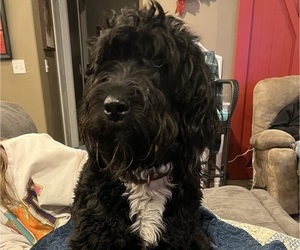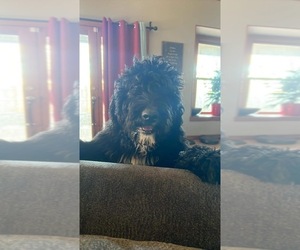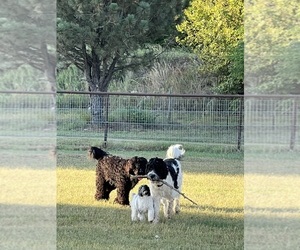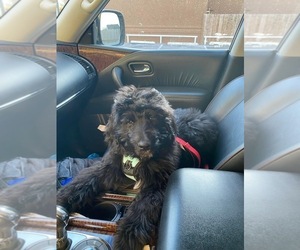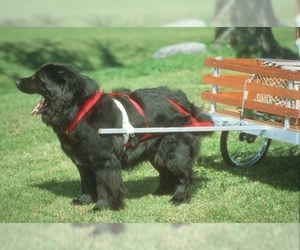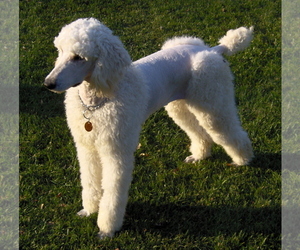All about Newfypoo dog breed
A.K.A. :Newfiedoodle, Newfydoodle, Newfpoo
Newfypoo is a mix of
Size
Grooming requirements
Exercise requirements
Good with other dogs
Watchdog ability
Energetic
Training requirements
Playful
Affectionate
Good with other pets
Good with children
Good with strangers
Winter
Summer
Healthiness
Protective
Life Span
| Mixed Breeds | Member |
| Breeds A - Z | N |
| Breeds by Group | Working |
| Breeds by Trait | Good With Kids Hypoallergenic Low Shedding Smartest Dog Breeds |
| Overview: | The Newfypoo, a charming crossbreed of the Newfoundland and Standard Poodle, originated from the desire to combine the gentle nature of the Newfoundland with the intelligence and low-shedding coat of the Poodle. Physically, they are large dogs, typically weighing between 70-120 pounds, with a luxurious, often wavy or curly coat that can range in color from black to brown, gray, or multi-colored. Their temperament is generally friendly, intelligent, and loyal, making them wonderful family companions, though early socialization is crucial. While adaptable, their size and need for moderate exercise make them better suited for homes with a yard rather than small apartments. Prospective owners should be aware of potential health concerns inherited from their parent breeds, such as hip and elbow dysplasia, bloat, and certain eye conditions. Regular grooming is essential to maintain their beautiful coat and prevent matting. |
F.A.Q.
All You Need to Know About the "Newfypoo" Breed (parent breeds: "Newfoundland" × "Poodle (Standard)")
The Newfypoo, a delightful cross between a Newfoundland and a Standard Poodle, offers the best of both worlds. Originating from designer breed programs, these intelligent and affectionate "doodles" are known for their gentle, friendly temperament, making them exceptional family dogs that typically get along well with children and other pets. Physically, Newfypoos are large, often sporting a wavy or curly, low-shedding coat inherited from their Poodle parent, which can range in color. While their size might suggest otherwise, with adequate exercise, they can adapt to apartment living, though a home with a yard is ideal. They require regular grooming to prevent matting and moderate exercise to keep them happy and healthy. Common health considerations include those found in their parent breeds, such as hip and elbow dysplasia, bloat, and certain heart conditions, highlighting the importance of responsible breeding. This hypoallergenic dog option is perfect for those seeking a loving, intelligent, and relatively low-shedding companion.The Newfypoo weight typically ranges from 70 to 130 pounds for a healthy adult. There can be some variation in average size between sexes; adult males generally fall into the higher end of this range, while females are often closer to the lower or middle end. This wide range reflects the diverse genetic contributions from their Newfoundland and Standard Poodle parents. When considering the healthy weight for Newfypoo, individual body condition and build should also be taken into account.
Newfypoo Height: What’s the Average Size of This Wonderful Hybrid?
Thinking about bringing a Newfypoo into your home and wondering how tall they’ll get? You’ve come to the right place! The Newfypoo, a charming cross between a majestic Newfoundland and an intelligent Standard Poodle, typically inherits a wide range of sizes, reflecting their parent breeds.On average, you can expect an adult Newfypoo to stand between 24 to 28 inches tall at the shoulder. This measurement refers to their height when standing upright, from the ground to the highest point of their shoulder blades.It's important to remember that this is an average size, and individual Newfypoo height can vary. Generally, male Newfypoos tend to be on the taller end of the spectrum, while females might be slightly shorter. However, genetics play a significant role, and even within the same litter, you might find pups that mature to different heights. Factors like the specific size of the parent Newfoundland and Poodle (some Standard Poodles are larger than others) will directly influence how tall is a Newfypoo.For potential adopters or buyers comparing breed dimensions, knowing this average range helps in picturing their adult size and ensuring your living space is suitable. While they are a large breed, their loving and gentle nature makes them wonderful companions!Newfypoo Colors: A Comprehensive Guide for AdoptersThe Newfypoo, a charming mix of Newfoundland and Standard Poodle, boasts a diverse range of beautiful Newfypoo colors, influenced by both parent breeds. While there's no official AKC recognized Newfypoo colors list (as Newfypoos are a hybrid breed), understanding the common and rare coat types can help potential owners.You'll commonly find Newfypoos in solid colors such as black, brown, and cream, inherited from both Newfoundlands and Poodles. White and apricot are also frequent. Many Newfypoos display attractive patterns like parti (patches of color on a white background), a common Poodle trait, and tuxedo (solid color with white markings on chest and paws).For those seeking exotic Newfypoo variations, colors like blue and silver (diluted black), and café au lait (diluted brown) are possible, particularly from the Poodle lineage. Chocolate (a rich, dark brown) is also a desired color. While less common, brindle (stripes of color) can occasionally appear, especially if there's any distant brindle in the Poodle's ancestry. Merle (marbled patches of color) is a beautiful, but rarer, coat pattern that can appear if the Poodle parent carried the merle gene; careful breeding practices are crucial for merle to avoid potential health issues. Lilac is an extremely rare diluted chocolate color, a true exotic find. These rarer colors and patterns often command higher pricing due to their unique genetic makeup and demand. When considering a Newfypoo, inquire about the parent breeds' colors and genetic health clearances to better anticipate your puppy's coat and health.
The Newfypoo personality is a delightful blend of its parent breeds, the Newfoundland and the Standard Poodle. You can expect a loyal, affectionate, and highly intelligent companion.Temperament of Newfypoo: Known for their incredibly friendly and gentle nature, Newfypoos are often described as “gentle giants.” They are very sociable and thrive on being part of the family, making them excellent companions for those seeking a dog deeply devoted to their owners. Their loyal disposition means they bond strongly with their families and are always eager to please.With Children and Other Pets: Newfypoos typically exhibit remarkable patience and gentleness with children, often displaying a protective yet soft demeanor. They generally get along wonderfully with other household pets, given proper introductions and socialization, thanks to their easygoing and friendly nature.Apartment Living: While adaptable, Newfypoos are not ideally suited for small apartment living due to their large size and moderate energy levels. They will be much happier in a home with a yard where they can stretch their legs and enjoy outdoor playtime. Regular exercise and mental stimulation are crucial to prevent boredom and ensure a well-behaved dog.
The Newfypoo temperament is a delightful blend, creating an exceptional companion dog behavior. Generally, they are known for their incredibly friendly and sociable nature, eager to please and form strong bonds. Expect a deeply loyal and affectionate dog that thrives on human companionship. Their personality traits often include a gentle and calm demeanor, making them excellent family pets. They are typically good with children due to their patient and tolerant nature, and their easygoing disposition usually extends to other pets. While adaptable, their size and need for moderate exercise mean they are not ideal for apartment living unless given significant outdoor time. They can show occasional stubbornness, a gentle echo from their Newfoundland lineage, but are generally intelligent and trainable, though sensitive to harsh correction. Positive reinforcement works best with their sensitive yet eager-to-please nature. Overall, the Newfypoo is a loving, gentle giant perfect for families seeking a devoted and engaging companion.
Newfypoo Care: Your Guide to Daily Maintenance & Health TipsCaring for a Newfypoo, a delightful cross between a Newfoundland and a Standard Poodle, involves understanding their unique needs. Newfypoo care focuses on maintaining their health and happiness.Grooming Needs: Newfypoos require regular grooming to prevent matting. Expect brushing several times a week, and professional grooming every 6-8 weeks for clipping and bathing. Their thick, wavy coat needs attention to avoid tangles.Exercise Limitations: Despite their size, Newfypoos are often described as a low-energy dog breed. They enjoy moderate daily exercise, like a good walk or playtime in a secure yard, but avoid strenuous activities, especially in warm weather. Their large size makes them prone to joint issues, so high-impact exercise should be limited.Dietary Considerations: Feed a high-quality, large-breed dog food appropriate for their life stage. Monitor their weight closely to prevent obesity, which can exacerbate joint problems. Consult your vet for specific dietary recommendations and portion control.Wrinkle and Ear Cleaning: While not typically brachycephalic, some Newfypoos may inherit loose skin or ear folds that require attention. Regularly check and gently clean their ears to prevent infections, and inspect any skin folds for irritation or moisture.Climate Sensitivity: Their thick coat makes them more tolerant of colder climates. However, they can overheat quickly in warm or humid weather. Ensure access to shade and fresh water, and avoid exercise during the hottest parts of the day.Common Health Concerns & Health Tips for Newfypoo: Be aware of potential health issues. Skin issues can arise from their dense coat if not properly groomed. Dental care is crucial; brush their teeth regularly and provide dental chews to prevent tartar buildup. Weight management is paramount due to their predisposition to joint problems like hip and elbow dysplasia. Regular vet check-ups are essential for early detection and management of health concerns. How to care for a Newfypoo effectively means proactive health management and consistent daily routines.
Newfypoo Activity Level: How Active Are Newfypoo?The Newfypoo, a delightful cross between the Newfoundland and the Standard Poodle, generally possesses a moderate activity level, balancing bursts of playful energy with a love for relaxed lounging. They aren't hyperactive dogs that constantly need to be on the go, making them adaptable to various household dynamics.Typical Energy Levels & Exercise Needs:Expect your Newfypoo to enjoy a good 30-60 minutes of daily exercise, which can be broken into several sessions. This could include a brisk walk, a game of fetch in the yard, or some supervised off-leash play in a secure area. While they appreciate activity, they are not typically high-stamina dogs built for endurance sports like marathon running. Mental stimulation through puzzle toys or training sessions is equally important to keep their intelligent minds engaged.Playtime Preferences:Newfypoos often love interactive games with their families, such as fetch, tug-of-war, or even just chasing after a ball. Many inherit the Poodle's love for water and enjoy swimming, especially on warmer days. They also cherish quiet cuddle time and are often content to nap at your feet after their exercise.Limitations Due to Brachycephalic Anatomy (Important Note for Some Newfypoos):It's crucial to understand that while the Poodle parent is not brachycephalic, some Newfoundlands (and therefore some Newfypoos) can have a slightly shorter snout or a tendency towards brachycephalic features, which can impact their ability to breathe efficiently, especially during exercise or in hot weather. Always consult with your breeder about the specific facial structure of the parent dogs and the potential for brachycephalic traits in your Newfypoo. For Newfypoos with any degree of brachycephaly, strenuous exercise in hot or humid conditions should be strictly avoided to prevent overheating and breathing difficulties. Even non-brachycephalic Newfypoos can be susceptible to overheating due to their thick coats, so always exercise caution in warm weather.Suitability for Families:Newfypoos strike a wonderful balance, making them suitable for both moderately active families who enjoy daily walks and playtime, as well as low-energy households that can commit to consistent, moderate exercise. They are generally not ideal for extremely sedentary lifestyles as they do require mental and physical engagement to thrive. Their ability to balance short bursts of energy with long periods of rest makes them versatile companions.
To understand how to keep Newfypoo healthy, owners should maintain a lean body weight to reduce strain on hips and spine, provide moderate but consistent exercise without overexertion, clean and dry skin folds regularly, monitor for allergy triggers, and avoid strenuous activity in hot weather. Routine veterinary checkups, especially for orthopedic and respiratory health, are essential for early detection and long-term management. With proactive care, adopters and buyers can ensure this affectionate and intelligent hybrid remains a strong, healthy, and happy companion.
Sources highlight that Newfypoos, due to their Newfoundland heritage, are prone to orthopedic problems and heat sensitivity, while their Poodle lineage adds risks of skin conditions and allergies.
Breed Breakdown: What Experts Say About the Newfypoo
I would rate the "Size" trait of the Newfypoo at a 9.The Newfypoo is a substantial dog, inheriting considerable size from both of its parent breeds. The Newfoundland is a giant breed, known for its immense weight, broad chest, and powerful build, while the Standard Poodle is a large, athletic dog with a lean but sturdy frame. As a result, the Newfypoo typically ranges from 22 to 28 inches in height and can weigh anywhere from 60 to 120 pounds, with some individuals potentially exceeding that, particularly if they lean more heavily on their Newfoundland genetics. Their body structure is generally robust and muscular, giving them a very solid and imposing presence. Compared to most other companion dog breeds, the Newfypoo stands out as a significantly large animal.Given their considerable size, Newfypoos are generally not well-suited for apartment living, travel, or households with significant space constraints. They require ample indoor space to move around comfortably without feeling cramped, and a secure, spacious yard for exercise is highly beneficial. Their size can also make travel challenging, requiring larger vehicles and often presenting difficulties in public spaces or pet-friendly accommodations.
I would rate the grooming requirements of the Newfypoo a 9.The Newfypoo inherits a coat that is almost universally high-maintenance, regardless of whether it leans more towards the Poodle's curly, non-shedding coat or the Newfoundland's thick, double coat. If it takes after the Poodle, regular brushing and professional grooming every 6-8 weeks for clipping are essential to prevent matting, which can quickly become severe and painful, potentially leading to skin infections underneath. If the Newfypoo inherits more of the Newfoundland's dense undercoat, it will be a heavy shedder, requiring daily brushing to manage loose hair and prevent mats, especially during seasonal shedding periods. Even a wavy, mixed coat will likely need significant attention to prevent tangles and mats due to the Poodle influence.Beyond the coat, both parent breeds have areas needing regular care. Floppy ears are common, requiring weekly checks and cleaning to prevent ear infections, a common issue in breeds with poor air circulation in the ear canal. Nail trimming needs to be done regularly, typically every 2-4 weeks, as long nails can lead to discomfort and structural problems. While skin folds are not a major concern unless they inherit a very loose skin from the Newfoundland, their thick coats can hide skin irritations or hot spots, especially if not dried thoroughly after bathing. Bathing will be a significant task due to their size and coat density, and likely needed every 4-8 weeks depending on activity and coat type. Compared to many other companion dogs, the Newfypoo requires very frequent and often specialized grooming, making it a demanding breed in this regard.
I'd rate the Newfypoo's exercise requirements at a 6. They generally fall into the moderate range, reflecting a blend of their parent breeds. The Poodle (Standard) contributes a good deal of energy and a need for mental stimulation, often enjoying extended walks and interactive play. The Newfoundland, while large, isn't known for being hyperactive, but they still benefit from regular, moderate activity to maintain their muscle mass and prevent obesity. Newfypoos typically thrive with at least 45-60 minutes of daily exercise, which could include a brisk walk, a good game of fetch, or a trip to a dog park. They aren't typically a breed that needs to run for miles, but they definitely aren't content with just lounging around all day. Structured routines, while not always strictly necessary, can be very beneficial for their physical and mental health, helping them burn off energy and preventing boredom, which can lead to destructive behaviors. While they aren't brachycephalic and therefore don't have those respiratory limitations, their larger size means owners should be mindful of extreme heat and overexertion, especially during puppyhood as their joints develop.
I'd rate the Newfypoo's watchdog ability at a 6 out of 10.While neither the Newfoundland nor the Poodle are typically renowned for their "tough guy" watchdog capabilities, they bring different elements to the table. The Newfoundland is incredibly gentle and famously lacks aggression, but its sheer size can be a deterrent, and it will often bark to alert its family to arrivals or unusual sounds. They are also highly sensitive to their environment and their family's well-being. The Standard Poodle, on the other hand, is quite intelligent, often more vocal, and surprisingly alert. They are known to bark at strangers approaching the home and are generally more suspicious of the unknown than a Newfoundland.A Newfypoo is likely to inherit a good degree of alertness and intelligence, making them aware of their surroundings. They will almost certainly bark to announce the presence of strangers or unusual activity, providing a valuable early warning system. Their size, inherited from the Newfoundland, can also be intimidating to a potential intruder, even if the dog itself isn't aggressive. However, their inherent friendliness and desire to please mean they are unlikely to be truly protective or confrontational in a dangerous way. They are more likely to be a "big, friendly alarm bell" rather than a deterrent through aggression. They'll let you know something's up, and their size might make someone think twice, but they're not a "guard dog" in the traditional sense. They are more a passive companion capable of providing meaningful early warnings.
Rating: 9/10The Newfypoo generally scores very high on the "Good with Other Dogs" trait due to the inherently sociable and gentle nature of both parent breeds. Newfoundlands are renowned for their calm temperament and tolerance, often acting as "nanny dogs" to other animals, while Standard Poodles, though sometimes initially reserved, are intelligent, adaptable, and usually get along well with other dogs once comfortable.A Newfypoo is likely to exhibit a friendly and accepting demeanor around unfamiliar dogs, often approaching with curiosity rather than aggression. Their size might lead them to be more cautious around very small, high-energy dogs, but their innate gentleness typically prevents any rough play. They tend to be compatible with dogs of various sizes and energy levels, often adapting their play style to suit their companions. While early socialization is beneficial for any puppy, Newfypoos usually thrive in canine company and are excellent candidates for multi-dog households. The potential for aggression or dominance is very low, making them a joy to introduce to existing pets. They generally require minimal careful introductions, often integrating smoothly, and thrive on the companionship of other dogs.
I'd rate the "Energetic" trait of a Newfypoo a 6 out of 10.Newfypoos generally land in the moderate energy range. While they inherit the Poodle's intelligence and desire for engagement, which can manifest as playful bursts and a need for mental stimulation, they also carry the Newfoundland's more laid-back, gentle giant temperament. This means they are far from couch potatoes, but also not typically demanding of constant, intense activity like some herding or terrier breeds. They enjoy walks, playtime, and a good romp in the yard, and can have surprisingly good endurance for activities like hiking, but they are also content to relax with their family. They require consistent daily exercise to stay healthy and happy, but aren't typically bouncing off the walls if they miss an occasional high-intensity session. The brachycephalic anatomy is not relevant here as neither parent breed, the Newfoundland nor the Standard Poodle, is brachycephalic, and therefore the Newfypoo would not inherit any associated limitations on stamina or exercise tolerance.
I'd rate the "Training Requirements" of the Newfypoo at a 6 out of 10.Newfypoos generally fall into the moderate-to-slightly-demanding category for training. They inherit a wonderful blend of intelligence from both the Newfoundland and Poodle, making them capable of learning a wide array of commands and tricks. However, while they are smart, they can also exhibit a touch of the Newfoundland's independent thinking or the Poodle's occasional stubborn streak, particularly if they are more heavily weighted towards one parent's personality. Their attention span is usually decent, especially during engaging training sessions, but they do require consistent and positive reinforcement to thrive. They respond very well to praise, treats, and play, making force-based methods counterproductive and damaging to their trusting nature. Consistency is absolutely key; if you’re not clear and repetitive with commands and expectations, they can become confused or decide to try and get away with things.While not exceptionally difficult, they are also not a "set it and forget it" breed. They are generally considered beginner-friendly, provided the beginner is committed to putting in consistent time and effort, understands the importance of positive reinforcement, and is prepared to attend puppy classes or seek professional guidance if needed. They truly benefit from structured routines, early socialization, and ongoing mental stimulation to prevent boredom and undesirable behaviors. They don't necessarily require experienced handling, but a proactive and dedicated owner will see the best results.
The Newfypoo, a cross between the Newfoundland and the Standard Poodle, would likely rate a 7 out of 10 for its "Playful" trait. This breed tends to be a wonderful balance of spirited and laid-back. While the Newfoundland parent brings a calm, gentle nature, the Standard Poodle injects a significant amount of intelligent energy and desire for interaction. Newfypoos generally enjoy games like fetch and tug-of-war, often displaying a silly and endearing side, especially when younger. They are usually quite responsive to toys and will actively seek out attention and playtime from their families, showing enthusiasm in daily interactions. However, they aren't typically as hyperactive as some other companion breeds, and once their playful energy is satisfied, they are usually content to relax and cuddle, making them more naturally spirited than entirely laid-back.
The Newfypoo's "Affectionate" trait rates a strong 9 out of 10. This hybrid inherits a profound desire for human companionship from both its Newfoundland and Poodle parents. Newfypoos are renowned for their loving and people-oriented nature, often described as "velcro dogs" due to their tendency to follow their family members from room to room. They thrive on affection and are not content to be independent; in fact, they can be prone to separation anxiety if left alone for extended periods. Physical closeness is a hallmark of the breed, with many Newfypoos enjoying cuddles and leaning into their owners. Their loyalty is unwavering, and they are highly sensitive to owner emotions, often offering comfort during times of distress. This breed absolutely thrives on affection and is far from independent compared to most other companion dogs, making them an excellent choice for those seeking a devoted and demonstrably loving canine companion.
I'd rate the "Good with Other Pets" trait of the Newfypoo a 9 out of 10.Newfypoos generally inherit the gentle and laid-back temperament of the Newfoundland, combined with the intelligence and eagerness to please of the Poodle. This often results in a highly adaptable and tolerant dog that can integrate well into multi-pet households. Their prey drive is typically low, especially towards smaller household animals like cats, as both parent breeds are not known for strong hunting instincts. While some individual variations will exist, resource guarding is not a predominant trait for either parent breed, and with proper early socialization, it's unlikely to be a significant issue for a Newfypoo. They are naturally sociable and generally enjoy the company of other dogs, and with early exposure and positive reinforcement, they can easily learn to coexist peacefully with cats and other smaller pets. Training and supervision are always beneficial for any dog to ensure harmonious living, but the Newfypoo's inherent good nature means they are often quite forgiving and willing to accept new animal companions with minimal fuss.
The Newfypoo rates a strong 9 out of 10 for "Good with Children."This high rating is largely inherited from its parent breeds, particularly the gentle giant Newfoundland. Newfypoos are renowned for their incredibly sweet, patient, and good-natured temperament. They possess an inherent desire to please and a remarkable tolerance for the unpredictable energy and noise that children bring. Their playfulness makes them excellent companions for active kids, but they are also calm and gentle enough to be around toddlers, often forming deep bonds with their "little humans." They are naturally affectionate and loving, usually viewing children as part of their pack to be protected and cherished. While all dogs benefit from early socialization and consistent positive reinforcement training, the Newfypoo's natural inclination towards gentleness and their high intelligence make them relatively easy to train in a family setting. Supervision is always recommended when children and pets interact, especially with very young children, but the Newfypoo's patience and even temper mean they are less likely to react negatively to accidental pulls or prods. They thrive on being included in family activities and are highly compatible with children of various ages, making them an exceptionally child-friendly breed.
I would rate the "Good with Strangers" trait of the Newfypoo a 9 out of 10.The Newfypoo generally inherits a wonderful balance from its parent breeds, making them highly sociable and welcoming with strangers. The Newfoundland's gentle giant nature contributes significantly to their calm and friendly demeanor, while the Standard Poodle's intelligence and desire to please ensure they are adaptable and eager to engage. They are naturally outgoing and typically greet new people with enthusiasm and a wagging tail, rather than suspicion. While individual personalities can vary, the breed as a whole is not prone to barking excessively at unfamiliar adults or displaying guarding tendencies; instead, they are more likely to seek affection. Their comfort in public and guest-filled environments is typically very high, making them excellent companions for social outings. While early socialization is always beneficial for any dog to reinforce good manners, the Newfypoo is naturally inclined to be comfortable and friendly with strangers, rather than requiring extensive training to overcome shyness or wariness.
I would rate the Newfypoo's winter tolerance at a 9. Both parent breeds, the Newfoundland and the Standard Poodle, possess excellent cold weather adaptations. Newfoundlands are renowned for their thick, double, water-resistant coats and substantial body fat, originally bred for work in icy waters. Standard Poodles, while often perceived as delicate, also have a dense, curly coat that provides good insulation, and they are active, robust dogs.A Newfypoo inherits a combination of these traits, typically resulting in a thick, often dense and curly or wavy coat that offers significant protection against cold and moisture. Their generally large size and good body mass further contribute to their ability to retain heat. They are not brachycephalic, so breathing in cold air is typically not an issue. The risk of hypothermia is relatively low for a healthy Newfypoo in most winter conditions, and they are generally capable of safely enjoying outdoor activities like walks and playtime even in cold climates. Compared to many other companion dogs, a Newfypoo is remarkably well-suited for winter and will likely thrive with regular outdoor exercise, often requiring less special care than breeds with thin coats or small body mass, though supervision and common sense regarding extreme temperatures are always necessary.
Rating: 3Explanation: The Newfypoo, a cross between the Newfoundland and the Standard Poodle, generally has a low "summer" tolerance. Both parent breeds are susceptible to heat. Newfoundlands are large, heavily coated dogs bred for cold water and have a very low heat tolerance. While the Standard Poodle's coat can be clipped, their denser fur and generally active nature still put them at risk. The Newfypoo typically inherits a thick, dense coat and a larger build, making it challenging for them to dissipate heat effectively. They are at a significant risk of heatstroke, even during moderate temperatures or with minimal activity. They are not brachycephalic, which is a positive, but their other physical traits outweigh this advantage. Outdoor activity should be severely limited to early mornings or late evenings in the summer, and only for short durations. They absolutely require climate control during hot weather and should be kept indoors in air conditioning. Compared to many other companion dogs, Newfypoos require substantial special care in summer months to prevent overheating and potential health emergencies.
I'd rate the Newfypoo's "Healthiness" trait a 7 out of 10.Newfypoos generally benefit from the hybrid vigor often seen in first-generation crosses, which can reduce the incidence of some single-gene recessive disorders prevalent in their parent breeds. However, they are not immune to the health issues that plague Newfoundlands and Standard Poodles. From the Newfoundland side, they can inherit predispositions to hip and elbow dysplasia, subvalvular aortic stenosis (SAS), and cystinuria. From the Poodle side, concerns include bloat, Addison's disease, sebaceous adenitis, and progressive retinal atrophy (PRA). Their deep chests inherited from the Poodle also make them susceptible to bloat.Their life expectancy is generally good for a large breed, typically ranging from 10 to 12 years. While they tend to be generally robust compared to some more delicate breeds, they are not considered low-maintenance in terms of health. Responsible breeding is crucial, involving extensive health screening of both parent dogs for the aforementioned conditions to minimize risks. Owners should also be prepared for potential high vet costs if genetic predispositions manifest. Preventive care, including appropriate diet, exercise, and regular veterinary check-ups, plays a significant role in their overall well-being.
The Newfypoo's "Protective" trait rates a 6 out of 10.While not inherently aggressive or a dedicated guard dog, the Newfypoo possesses a loyal and watchful nature inherited from both parents, particularly the Newfoundland's protective instincts over its "flock." They are typically alert to their surroundings and will often bark to signal the arrival of strangers, making them effective watchdogs. Their imposing size, especially when mature, can be a deterrent to uninvited guests. However, their generally friendly and gentle disposition means that while they might be a formidable presence and vocal about intruders, they are more likely to be a companion dog that barks a warning rather than actively engaging in a protective or aggressive manner. They are deeply devoted to their families, and this loyalty fuels their desire to keep them safe, but their primary method of "protection" is usually through signaling and a somewhat intimidating presence rather than direct confrontation. They are capable of offering meaningful warning and a sense of security due to their size and alertness, but they are not the type of dog to be relied upon for intense physical guarding.
I'd rate the "Life Span" trait of the Newfypoo a 6 out of 10.The Newfypoo generally falls into the average to slightly above-average range for companion dogs, though it's not considered exceptionally long-lived. Standard Poodles typically boast excellent longevity, often living 12-15 years or even more, while Newfoundlands have a shorter average lifespan, usually 8-10 years, primarily due to their large size and predispositions to certain health issues like heart conditions (subvalvular aortic stenosis) and cancer. The Newfypoo, being a mix, often inherits a life expectancy that lands somewhere in between, generally around 10-12 years. While the Poodle's genetics can contribute to a healthier and potentially longer life than a purebred Newfoundland, the larger size of the Newfypoo (compared to a Standard Poodle) still carries some of the risks associated with larger breeds. Responsible breeding practices, including health screening of parent dogs for conditions like hip and elbow dysplasia, cardiac issues, and certain cancers, significantly impact the potential lifespan. Good nutrition, regular exercise, and preventative veterinary care also play a crucial role in maximizing a Newfypoo's lifespan.
Newfypoo Dogs for adoptionSee all dogs for adoption
Newfypoo BreedersSee all breeders
Similar Dog Breeds for Newfypoo
Quick Breed Selector 0 - not important, 1 - smallest, 10 - largest
Variants & Mistakes :Newfipoo, Newfiepoo, Newfapoo, Newfepoo, Newfupo, Newfupoo, Newfpoo, Newfpo, Newfopoo, Newfpaw, Newfy poo, Newfy-poo, Newfyoo, Newfiyoo, Nufypoo, Nufipoo, Nufiepoo, Nuffypoo, Nuffiepoo, Neufypoo, Neufipoo, Neufiepoo, Noofypoo, Noofipoo, Noofiepoo, Newfapo, Newfipo, Newfopo, Newfi poo, Newfie Poo, Nufy Poo, Nufi Poo, Nuffy Poo, Nuffy-Poo, Newfeepoo, Newfeepo


